Life in our water
In Campbelltown we have a number of species that call our wetlands, ponds and rivers home.
These creatures play a vital role in keeping the natural balance of the ecosystem healthy.
Let's explore a few of the main species that you can easily spot around our waters. You might be surprised at some of the amazing features they have that allow them to thrive in our waterways
Black Swan (Cygnus atratus)
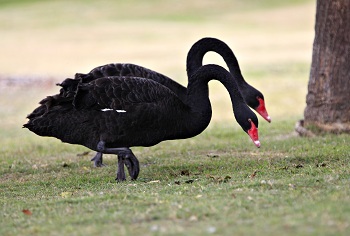
Black Swans are, as you would imagine, mostly black, with the exception of the broad white wing tips which are visible in flight. They are the only entirely black-coloured swan in the world. The bill is a deep orange-red, paler at the tip, with a distinct narrow white band towards the end. The younger birds are much greyer in colour, and have black wing tips.
How Black Swans feed and breed
Black Swans are vegetarian, with a diet of algae and weeds. The swan get its food by plunging its long neck into water up to one metre deep. Occasionally, they will graze on land, but they are clumsy walkers.
Black Swans pair for life, with both adults raising one chick per season. The eggs are laid in an untidy nest made of reeds and grasses. The nest is placed either on a small island or floated in deeper water. When the chicks are born they are fully covered in grey down, and are able to swim and feed themselves as soon as they hatch.
To find out more, visit Birds in Backyards
Purple Swamphen (Porphyrio porphyrio)
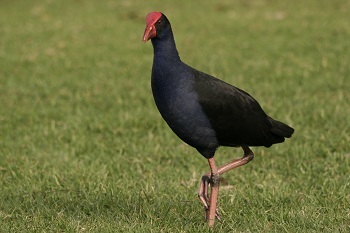
The Purple Swamphen is mainly dusky black above, with a dark blue collar, and dark blue to purple below. As it walks, it flicks its tail up and down, revealing its white undertail. The bill is red and the legs and feet orange-red. Although it may look a little gangly, it is a very good flier and will often take to the sky to escape danger.
How Purple Swamphen feed and breed
Purple Swamphens love to eat the soft shoots of reeds and rushes, as well as small animals, such as frogs and snails. It is also known for its deviant egg stealing and will eat ducklings when it can catch them.
Purple Swamphens are generally found in small groups and more than one male will mate with a single female. All family members, and occasionally the young from a previous brood, share in caring for the young. The nest consists of a platform of trampled reeds, with the surrounding vegetation sometimes being used to form a shelter.
To find out more, visit Birds in Backyards
Pacific Black Duck (Anas superciliosa)

The Pacific Black Duck is mostly brown in colour, with a characteristic dark brown line through the eye, bordered with cream above and below and a dark brown crown. It has a bright glossy green patch in the feathers.
How Pacific Black Duck feed and breed
The Pacific Black Duck is mainly vegetarian, feeding on seeds of aquatic plants. It will sometimes add small crustaceans, molluscs and aquatic insects to the diet. They retrieve their food by 'dabbling', where the bird plunges its head and neck underwater and upends, raising its rear end vertically out of the water.
When there is enough food and water, or there has been a heavy rain, the Pacific Black Duck will mate. To court one another, the ducks will perform a ritualised display, including preening, bobbing and wing-flapping. There may be two broods raised in a year, which seems like a large number, however, approximately only 20% of these will survive past two years of age.
To find out more, visit Birds in Backyards
Eurasian Coot (Fulica atra)
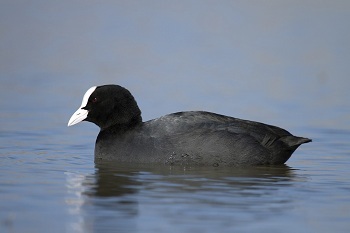
You will recognise the Eurasian Coot by its white snowy bill. The rest of the bird is dark sooty grey, except for its bright red eye. Immature birds are generally paler than adults, with a white wash on the throat.
How Eurasian Coot feed and breed
To find its food, the Eurasian Coot will predominately dive under water to a depth of up to seven metres sometimes holding its breath for 15 seconds. Here in Australia, Eurasian Coots feed almost entirely on vegetable matter, with a few insects, worms and fish thrown in, whereas their brothers and sisters of the northern hemisphere will feed more on animal prey.
Eurasian Coots will breed any time of the year. When they begin to breed, pairs will establish and maintain a territory with aggression! Nests of ducks are often seized and used as roosting sites, with the unfortunate owner's eggs being pushed off into the water and young ducks sometimes killed. The nest is often a floating raft of vegetation or is built on logs or tree stumps that are surrounded by water.
To find out more, visit Birds in Backyards
Australian Wood Duck (Chenonetta jubata)
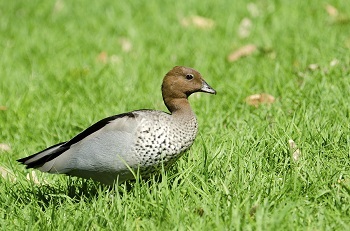
The Australian Wood Duck is a medium-sized 'goose-like' duck with a dark brown head and a pale grey body with two black stripes along the back. Males have the darker head with a black lower belly and undertail, whille the females have a paler head with two white stripes, above and below the eye, and a white lower belly and undertail. They prefer to relax on land, often seen perched on logs and in trees, only taking to open water when disturbed.
How Australian Wood Duck feed and breed
The Australian Wood Duck eats grasses, and other herbs it can find growing. It will occasionally treat itself to insects. It is rarely seen on open water, preferring to forage by dabbling in shallow water, or in grasslands and crops. Groups of ducks like to chat with one another when feeding.
The Australian Wood Duck will only breed in one pair year round. It will nest in tree holes, above or near water, often re-using the same site. Both parents feed young and young birds remain with them up to a month after fledging. Like other waterbirds, the Australian Wood Duck is born with a waterproof down allowing it to enter the water almost straight away.
To find out more, visit Birds in Backyards
Willie Wagtail (Rhipidura leucophrys)
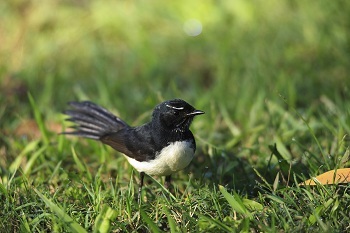
Although the Willie Wagtail does not solely live around or in the water, it is a bird that we see a lot of around our waterways. The Willy Wagtail has a black plumage and a white belly. The name wagtail stems from the constant sideways wagging of the tail. Young birds resemble the adults, but have paler, slightly rusty edges to the feathers of the wings.
How Willie Wagtails feed and breed
Willie Wagtails are active feeders, darting around our open areas, hunting for insects on the ground. As they do, the tail is wagged from side to side. You will often find the Willie Wagtail in the company of cattle and sheep, running behind the moving animal snatching insects as they are disturbed, or sitting on the animal's back, darting off to capture a flying insect and then returning to its mobile perch.
The Willie Wagtail lays cream-coloured eggs, speckled with grey and brown that are incubated by both sexes. The young birds stay with the parents until their younger siblings come along, at which point they are driven away. Their nest is a neatly woven cup of grasses, covered with spider's web on the outside and lined internally with soft grasses, or hair or fur taken directly from an animal. Nests are normally built on a horizontal branch of a tree, or other similar structure.
To find out more, visit Birds in Backyards
Longfinned Eel (Anguilla reinhardtii)
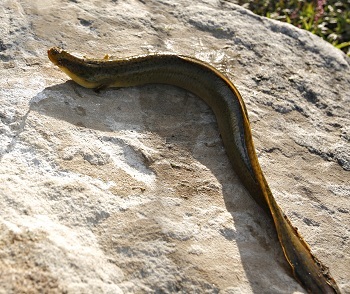
The Longfinned Eel has a broad head, and a large mouth with fleshy lips with olive or brown blotches above and on the sides, fading to pale on the belly.
How Longfinned Eel feed and breed
The Longfinned Eel likes to eat their food "live"
When they are small they will feed on insect larvae, worms and water snails, and as they get bigger, they begin to feed on fish, crayfish and even small birds like ducklings. Eels play a vital role in keeping the ecosystem of a waterway in balance. If there were too many ducks or other types of waterbirds, the water would become too rich in nutrients (from droppings) and the water would become unsuitable for all life living in that waterway.
The Longfinned Eel has an amazing lifecycle
They start their life as clear larvae, all the way from New Caledonia. They then drift to the coast of Australia and find their way into our waterways. Once they find a good food source, they settle down for around 50 years and then before they pass away they make their way back to New Caledonia to breed. And so the cycle happens again and again!
Find out more about the amazing journey of the Longfinned Eel in Eric the Eel(PDF, 4MB) - an illustrated storybook created by local students.